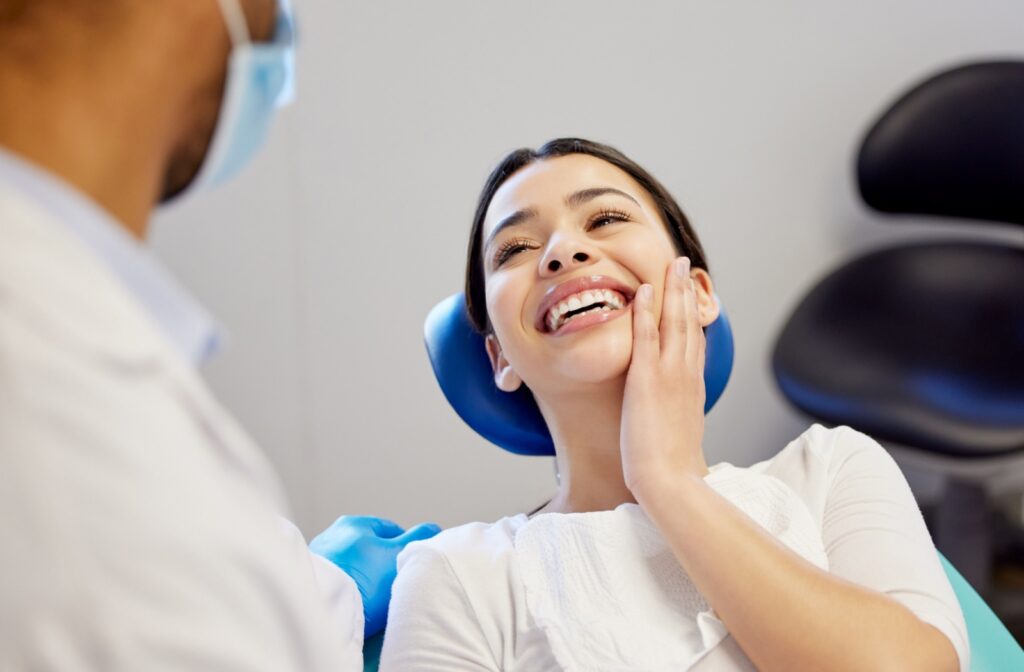Dental procedures can seem daunting at first—especially when you hear a term like “dental freezing.” Dental freezing, or numbing, is a common part of many dental visits. It’s designed to manage pain and comfort levels to make dental care less stressful for patients.
Dental freezing typically lasts between 1 to 3 hours, depending on the type of anesthetic used and other, individual factors. However, freezing isn’t always necessary. Through alternative treatments like the Solea laser, you may be able to avoid dental freezing altogether!
How Dental Freezing Works
Dental freezing is a process used to numb a specific area of the mouth before a dental procedure. It involves the use of local anesthetics that temporarily block nerve signals in the area.
Local anesthetics used in dental procedures can vary. However, they’re all designed to keep you more comfortable during the procedure. Your dentist may recommend one over the other depending on:
- The specific area being treated
- Your comfort levels
- Whether or not you’re experiencing dental anxiety
- The duration of the procedure
- Any allergies or sensitivities you may have
The process begins with your dentist applying a topical gel to numb the surface of your gums. Next, a local anesthetic is injected into the area being treated. You may notice a brief tingling or pressure sensation, but this should quickly subside.
Within a few moments, the anesthetic should take effect. Then your dentist can begin the procedure. You shouldn’t need to worry about significant discomfort.
Does Every Dental Procedure Need Freezing?
Dental freezing plays a crucial role in managing pain and discomfort. While freezing helps for some procedures, it isn’t always required. Typically, dental freezing is recommended for procedures such as:
These procedures all involve work that could cause discomfort without a numbing agent. Your dentist will assess the need for freezing based on the complexity and sensitivity of the area.
When Does Dental Freezing Go Away?
The duration of dental freezing can vary depending on a few factors. Typically, it should fade in somewhere between 1–3 hours, though some effects might linger. This depends on:
- The type and amount of anesthetic used
- The specific area of the mouth that was treated
- Whether or not additional doses were needed
- How you metabolize drugs
- Your age
- Your anxiety levels
It’s essential to follow your dentist’s advice on post-procedure care. If you have any concerns before, during, or after the procedure, ask your dentist or surgeon. It’s helpful to be prepared for when sensation in the frozen area returns.
To manage discomfort, it’s advisable to avoid chewing on the numbed side of your mouth until the freezing has fully worn off. As feeling returns to the frozen area, you might experience a tingling sensation. This is normal, so don’t panic. However, if these sensations last for more than about 6-8 hours, contact your dentist for further instructions.
The Benefits of Trying Solea Laser
While dental numbing is beneficial and makes many procedures easier, it isn’t always necessary—especially when the Solea laser exists.
The Solea laser takes a needle-free approach to dentistry. It uses a low-level laser to perform procedures that otherwise would need a drill or scalpel. As the laser works, it simultaneously numbs the area without injections and needles. It’s quick, efficient, and accurate.
Solea laser technology offers an exciting alternative to traditional dental methods. It often minimizes, or even removes, the need for dental freezing for some procedures. This technology is capable of performing procedures with precision and comfort while reducing reliance on anesthetics.

Using the Solea laser can lead to quicker procedures and a more relaxed experience. You don’t need to worry about needles or invasive procedures. Instead, it’s a comfortable and relaxing experience!
What Can the Solea Laser Do?
The Solea laser is versatile and can be used for a variety of dental procedures. Some treatments that can benefit from Solea’s technology include:
- Cavity preparation, where the laser removes decay without noise or vibrations
- Gum treatments, as it can remove diseased tissue with precision
- Tongue-tie releases without the need for anesthesia in infants and children
Overall, Solea’s technology simplifies many dental procedures that were once complex or uncomfortable. There is often no need for needles, numbing agents, or invasive tools.
Patients often experience less bleeding and swelling and the healing process is typically faster. This makes Solea an efficient and patient-friendly choice. It’s a wonderful advancement in the field of modern dentistry.
Try Solea Laser with Genesis Dental
Choosing the right dental care option can make all the difference in the world. And here at Genesis Dental, we’re ready to help make your experience efficient, comfortable, and accurate. Through technology like the Solea laser, our team is ready to help. Contact our team today to schedule your visit and learn more about the benefits of laser dentistry.




